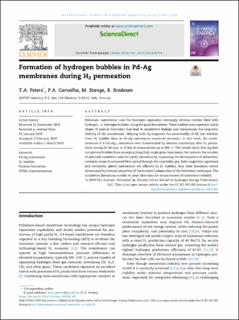| dc.contributor.author | Peters, Thijs | |
| dc.contributor.author | Almeida Carvalho, Patricia | |
| dc.contributor.author | Stange, Marit Synnøve Sæverud | |
| dc.contributor.author | Bredesen, Rune | |
| dc.date.accessioned | 2020-11-24T12:47:37Z | |
| dc.date.available | 2020-11-24T12:47:37Z | |
| dc.date.created | 2019-06-04T15:50:44Z | |
| dc.date.issued | 2019 | |
| dc.identifier.citation | International journal of hydrogen energy. 2019, . | en_US |
| dc.identifier.issn | 0360-3199 | |
| dc.identifier.uri | https://hdl.handle.net/11250/2689353 | |
| dc.description.abstract | Palladium membranes used for hydrogen separation seemingly develop cavities filled with hydrogen, i.e. hydrogen bubbles, along the grain boundaries. These bubbles may represent initial stages of pinhole formation that lead to unselective leakage and compromise the long-term stability of the membranes. Alloying with Ag improves the permeability of Pd, but whether these H2 bubbles form in Pd-Ag membranes remained unknown. In this work, the microstructure of a Pd77Ag23 membrane was characterized by electron microscopy after H2 permeation testing for 50 days at 15 bar at temperatures up to 450 C. The results show that Ag does not prevent bubbles from emerging along high-angle grain boundaries, but reduces the number of potential nucleation sites for cavity formation by supressing the development of dislocation networks when H-saturated Pd is cycled through the miscibility gap. Both magnetron-sputtered and electroless plated membranes are afflicted by H2 bubbles, thus their formation seems determined by intrinsic properties of the material independent of the fabrication technique. The qualitative discussion enables to point directions for enhancement of membrane stability. | en_US |
| dc.language.iso | eng | en_US |
| dc.publisher | Elsevier | en_US |
| dc.rights | Attribution-NonCommercial-NoDerivatives 4.0 Internasjonal | * |
| dc.rights.uri | http://creativecommons.org/licenses/by-nc-nd/4.0/deed.no | * |
| dc.subject | STEM characterisation | en_US |
| dc.subject | Pinhole formation | en_US |
| dc.subject | H2 bubbles | en_US |
| dc.subject | Pd-Ag membrane | en_US |
| dc.title | Formation of hydrogen bubbles in Pd-Ag membranes during H2 permeation | en_US |
| dc.type | Peer reviewed | en_US |
| dc.type | Journal article | en_US |
| dc.description.version | publishedVersion | en_US |
| dc.rights.holder | © 2019 The Authors. Published by Elsevier Ltd on behalf of Hydrogen Energy Publications LLC. This is an open access article under the CC BY-NC-ND license (http://creativecommons.org/licenses/by-nc-nd/4.0/) | en_US |
| dc.source.pagenumber | 9 | en_US |
| dc.source.volume | 45 | en_US |
| dc.source.journal | International journal of hydrogen energy | en_US |
| dc.source.issue | 12 | en_US |
| dc.identifier.doi | 10.1016/j.ijhydene.2019.02.001 | |
| dc.identifier.cristin | 1702746 | |
| dc.relation.project | EU/FCH JU 671396 | en_US |
| dc.relation.project | Norges forskningsråd: 215666 | en_US |
| dc.relation.project | Norges forskningsråd: 281824 | en_US |
| cristin.unitcode | 7401,80,62,0 | |
| cristin.unitname | Bærekraftig energiteknologi | |
| cristin.ispublished | true | |
| cristin.fulltext | postprint | |
| cristin.qualitycode | 1 | |

